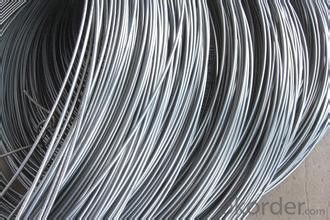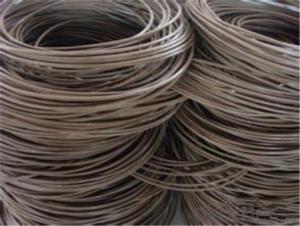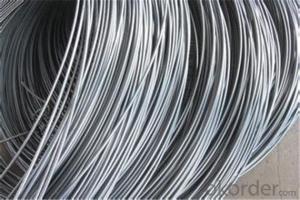Hot Rolled Steel Wire Rod 6.5mm with in China
- Loading Port:
- Shanghai
- Payment Terms:
- TT OR LC
- Min Order Qty:
- 500 m.t.
- Supply Capability:
- 45555555 m.t./month
OKorder Service Pledge
OKorder Financial Service
You Might Also Like
Item specifice
Description of wire Rod:
Diameter: 5.5mm,6.5mm,8mm,9mm,10mm,11mm,12mm
Grade:SAE1006/1008/1010/1012 /1015/1018
Coil weight:about 2 tons
Festures of wire Rod:
1. Drawn wire specialist, your wire rod solution
2. ISO9001 Certified Mill &SGS
3. Feature: machinability, high hardness, toughness, corrosion resistant
4. Customized service for your special requirement
5. Reasonable and more competitive mill price for you.
Specifications of wire Rod:
Product | steel wire rod |
Standard | AISI, ASTM, BS, DIN, GB, JIS |
Material/steel grade | Q195-Q235,SAE1006, SAE1008, SAE1010, SAE1018, SAE1020 or according to customers requirements |
Wire Gauge | 5.5-12mm |
Coil weight | 1.8-2.1mts |
MOQ | 25MT |
Delivery Time | 15-30 days after receipt of L/C or deposit by T/T |
Packing | In coil and load in container, if large quantity, by bulk vessel; Can be packed as customers' special requirements |
Payment terms | 1).100% irrevocable L/C at sight. |
Application | widely used in machinery parts |
Images of wire Rod:

FAQ:
1. What is your package?
Packing situation: standard seaworthy packing or as customer required.
2. How long is the lead time?
Delivery time: 45 days after order confirmed.
- Q:How is steel wire rod used in the manufacturing of wire forms for musical instruments?
- Steel wire rod is an essential component in the manufacturing of wire forms for musical instruments. It serves as the base material for creating various wire shapes, such as springs, hooks, and braces, which are crucial for holding instrument parts together or providing tension. The high-quality and strength of steel wire rod ensure durability and reliability in these wire forms, enabling musicians to produce precise and harmonious sounds from their instruments.
- Q:What are the main factors influencing the choice of steel wire rod coating?
- The choice of coating for steel wire rods is impacted by several key factors: the intended use, environmental conditions, durability needs, and cost considerations. First and foremost, the intended application of the wire rod is crucial in determining the appropriate coating. Different coatings offer specific properties like corrosion resistance, lubricity, or electrical conductivity. For instance, if the wire rod will be used outdoors or exposed to moisture, a corrosion-resistant coating like zinc or zinc-aluminum is preferred. On the other hand, if the wire rod is intended for electrical purposes, a coating with high electrical conductivity may be necessary. Secondly, the environmental conditions in which the wire rod will be utilized also play a significant role in coating selection. Factors such as temperature, humidity, exposure to chemicals, and UV radiation can impact the coating's performance and durability. Therefore, coatings that exhibit excellent resistance to these environmental factors are often chosen. Durability requirements are another influential factor. Depending on the wire rod's intended lifespan and the level of wear and tear it will face, different coatings with varying levels of durability may be chosen. Some coatings, such as epoxy or polyurethane, offer exceptional resistance to abrasion and impact, making them suitable for applications involving frequent handling or harsh environments. Lastly, cost considerations are important in coating selection. Different coatings come at different price points, and the cost must be balanced with desired performance and durability. It is crucial to choose a coating that meets requirements at a reasonable cost, ensuring a cost-effective solution without compromising the wire rod's performance. In conclusion, the choice of coating for steel wire rods hinges on the intended application, environmental conditions, durability needs, and cost considerations. By taking these factors into account, manufacturers can select the most suitable coating that provides the necessary properties and durability for the specific application while remaining cost-effective.
- Q:What are the main factors influencing the choice of steel wire rod order packaging marking options?
- When choosing the packaging marking options for steel wire rod orders, several factors come into play. Firstly, compliance with industry standards is crucial. Each industry may have its own specific requirements for markings on packaging materials. These standards ensure that the product can be easily identified and tracked throughout the supply chain. Adhering to these standards is essential for smooth operations and regulatory compliance. Secondly, customer requirements play a significant role. Customers may have specific labeling or marking preferences based on the destination of the product, their own branding needs, or other identification requirements. Meeting these requirements is vital for customer satisfaction and maintaining strong business relationships. Lastly, logistical considerations also impact the choice of packaging marking options. The way the steel wire rod orders are handled during transportation, storage, and loading/unloading can influence the placement of markings. For instance, if orders are frequently stacked or stored in specific orientations, the markings should be positioned accordingly to ensure easy identification and handling. Additionally, the size, shape, and material of the packaging itself need to be taken into account when determining the most suitable marking options. In conclusion, the choice of packaging marking options for steel wire rod orders is influenced by industry standards, customer requirements, and logistical considerations. By carefully considering these factors, businesses can ensure effective and efficient packaging marking solutions that meet the needs of all stakeholders involved.
- Q:How is steel wire rod used in the manufacturing of wire baskets for industrial applications?
- Steel wire rod is a primary material used in the manufacturing of wire baskets for industrial applications. It serves as the base material that is shaped, bent, and welded to create the framework of the basket. The high tensile strength and durability of steel wire rod make it ideal for withstanding heavy loads and rough handling in industrial environments. Additionally, the steel wire rod can be coated or galvanized to enhance corrosion resistance, ensuring longevity and reliable performance of the wire baskets.
- Q:What are the different types of steel wire rod coatings used for improved ductility?
- Enhancing ductility in steel wire rods involves the utilization of various coatings. These coatings are applied to the surface of the wire rod, serving as a protective layer and improving its mechanical properties. Commonly used coatings include: 1. Zinc Coating: Zinc coatings are extensively utilized for steel wire rods due to their exceptional corrosion resistance and ability to enhance ductility by minimizing the formation of brittle intermetallic compounds. Hot-dip galvanizing, the most prevalent method, involves immersing the wire rod in molten zinc. 2. Copper Coating: Copper coatings are often combined with zinc coatings to provide additional protection against corrosion. Copper aids in enhancing ductility by reducing the formation of brittle phases and improving the wire rod's resistance to cracking during deformation. 3. Phosphate Coating: Steel wire rods are treated with phosphate coatings to enhance lubricity and reduce friction during drawing and forming processes. Moreover, these coatings enhance adhesion between the wire rod and subsequent coatings like zinc or copper. 4. Polymer Coating: Polymer coatings, such as epoxy or polyvinyl chloride (PVC), are employed to establish a protective layer against corrosion and enhance ductility. These coatings function as a barrier, preventing moisture and corrosive substances from penetrating the wire rod and its surroundings. 5. Chromium Coating: Chromium coatings are commonly utilized in high-strength steel wire rods to enhance ductility and minimize the risk of hydrogen embrittlement. These coatings bolster the wire rod's resistance to cracking, thereby enhancing its mechanical properties. It is important to consider that the choice of coating depends on the specific application and desired properties of the steel wire rod. Different coatings offer varying levels of corrosion resistance, lubricity, and adhesion, allowing customization to meet the requirements of diverse industries and applications.
- Q:How are steel wire rods used in the manufacturing of cables?
- Steel wire rods are commonly used in the manufacturing of cables as they provide strength, durability, and flexibility to the final product. These rods are typically drawn into thinner wires and then braided or twisted together to form the core of the cable. This core provides the necessary tensile strength and conductivity required for transmitting electrical signals or supporting heavy loads. Additionally, steel wire rods can be coated with materials such as copper or zinc to enhance conductivity and resist corrosion, further improving the overall performance and lifespan of the cables.
- Q:How is steel wire rod used in the manufacturing of wire mesh conveyor belts?
- Steel wire rod is used in the manufacturing of wire mesh conveyor belts as it serves as the base material for creating the wire mesh. The steel wire rod is drawn and shaped into individual wires that are then woven together to form the mesh pattern of the conveyor belt. This process helps to provide strength, durability, and flexibility to the belt, making it suitable for various industrial applications such as conveying heavy loads or high-temperature materials.
- Q:How are steel wire rods used in the production of screws and bolts for mechanical assemblies?
- Screws and bolts for mechanical assemblies require steel wire rods as a crucial component. These wire rods are made from high-quality steel, which provides the necessary strength and durability for the fasteners. To begin the production process, the wire rods are heated and then passed through a series of rollers to reduce their diameter. This process, called wire drawing, ensures that the wire rods achieve the desired thickness and smoothness required for manufacturing screws and bolts. The wire rods are then cut into smaller lengths, which serve as the foundation for individual fasteners. Following this, the wire rods undergo a cold heading process. In this process, the wire rod is placed into a die and pressure is applied to shape it into the desired screw or bolt head. Cold heading not only forms the head but also creates the necessary thread on the shank of the fastener. This threading is essential as it allows the screws and bolts to securely fasten different components together. After the cold heading process, additional treatments may be applied to enhance the performance of the screws and bolts. These treatments can include heat treatment to further strengthen the steel, plating or coating for corrosion resistance, or specific coatings for improved lubrication during assembly. Once the screws and bolts are fully formed and treated, they are packaged and prepared for distribution to various industries that rely on mechanical assemblies. These fasteners play a crucial role in ensuring the stability and functionality of machinery, vehicles, and structures by securely holding different components together. In conclusion, steel wire rods undergo processes like wire drawing and cold heading to produce screws and bolts. These fasteners, with their threaded shanks, are then used in mechanical assemblies to provide a secure and reliable means of joining components together.
- Q:How are steel wire rods used in the manufacturing of wire ropes?
- Steel wire rods are an essential component in the manufacturing of wire ropes. These wire rods serve as the raw material for producing the individual wires that are twisted together to form the rope. The first step in the manufacturing process involves drawing the steel wire rods through a series of dies to reduce their diameter and increase their length. This process is known as wire drawing and results in wires of different sizes and strengths. Once the desired wires are obtained, they are then twisted together in a specific pattern to form strands. These strands are typically twisted in a helical manner around a core, which can be another wire or a fiber material. The number of strands and the direction of the twist depend on the intended use and load requirements of the wire rope. The steel wire rods used in this process are specifically chosen for their high tensile strength, durability, and resistance to corrosion. Steel is known for its excellent strength-to-weight ratio, making it ideal for applications requiring reliable and robust wire ropes. Moreover, the quality of the steel wire rods plays a crucial role in determining the performance and longevity of the wire rope. The steel must meet stringent specifications to ensure that it can withstand heavy loads, extreme weather conditions, and repetitive stress without compromising the integrity of the wire rope. In conclusion, steel wire rods are transformed into wires through wire drawing and subsequently used in the manufacturing of wire ropes. These wire ropes find applications in various industries, such as construction, mining, maritime, and transportation, where they are relied upon for their strength, durability, and ability to withstand demanding conditions.
- Q:How are steel wire rods used in the production of wire ropes for elevators?
- Steel wire rods are used as the primary material for producing wire ropes for elevators. These rods are first drawn into long, thin wires that are then twisted or braided together to form a strong and flexible rope. The high tensile strength and durability of steel make it ideal for ensuring the safety and reliability of elevator systems.
1. Manufacturer Overview |
|
|---|---|
| Location | |
| Year Established | |
| Annual Output Value | |
| Main Markets | |
| Company Certifications | |
2. Manufacturer Certificates |
|
|---|---|
| a) Certification Name | |
| Range | |
| Reference | |
| Validity Period | |
3. Manufacturer Capability |
|
|---|---|
| a)Trade Capacity | |
| Nearest Port | |
| Export Percentage | |
| No.of Employees in Trade Department | |
| Language Spoken: | |
| b)Factory Information | |
| Factory Size: | |
| No. of Production Lines | |
| Contract Manufacturing | |
| Product Price Range | |
Send your message to us
Hot Rolled Steel Wire Rod 6.5mm with in China
- Loading Port:
- Shanghai
- Payment Terms:
- TT OR LC
- Min Order Qty:
- 500 m.t.
- Supply Capability:
- 45555555 m.t./month
OKorder Service Pledge
OKorder Financial Service
Similar products
New products
Hot products
Related keywords




























